Ice core stratigraphy
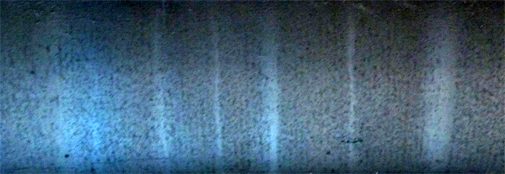 Melt layers in the NEEM ice we have seen so far are rare because the temperature usually does not exceed 0 deg C. However, occasionally we notice a clear bubble-free layer in the core that is an indication of melt. This image shows a unique 20 cm long core section from about 1000 BC that contains no less than seven melt layers. The section represents more than one year’s precipitation, but the melting has only occurred in the summer. Most likely the melt water penetrated the snow at the surface whereby several melt layers were formed at different depths.
Melt layers in the NEEM ice we have seen so far are rare because the temperature usually does not exceed 0 deg C. However, occasionally we notice a clear bubble-free layer in the core that is an indication of melt. This image shows a unique 20 cm long core section from about 1000 BC that contains no less than seven melt layers. The section represents more than one year’s precipitation, but the melting has only occurred in the summer. Most likely the melt water penetrated the snow at the surface whereby several melt layers were formed at different depths.
In the NEEM ice we have been through so far, the visual ice core stratigraphy is in general not very exciting. Mostly, the ice is clear with many air bubbles. From time to time certain interesting features do however occur such as a volcanic ash layer, a dust layer, or melt layers. The annual layering in the ice is of course there but it is normally not visible to the naked eye. Only when we measure the ice in the Dielectric Profile (DEP), the Electrical Conductivity Measurement (ECM), the Continuous Flow Analysis (CFA), or analyze the isotopic composition of the ice we can identify the annual layering.
What we have done today:
- Drilling with the NEEM long drill: 24.48 m. Drillers depth: 904.48 m.
- Logging brittle zone ice. Final depth: 598.95 m.
- Ice core processing: 16.50 m. Depth: 581.90 m.
- CFA analysis: 4.40 m. Depth: 252.45 m.
- Extending and sampling Korean pit for chemistry and isotopes.
- Checked seismic station.
- Barbecuing outside at -4°C
Ad.1: Drillers Report July 4: ‘A shorter work day recovered 19.45 metres of core and finished at 880 m this Saturday.’
Ad 2+3: We are continuing to log and process the ice in the transition into the brittle-zone for a few more days. When the logging and/or the processing starts to make serious ‘damage’ to the core we will stop processing. So far, the Swiss saw rarely introduce any breaks, whereas ECM and the other saw cuts more and more frequently breaks the core. The logging will go on throughout the brittle-zone, but if the separation into 1.65 m sections repeatedly introduces breaks in the core we will also stop sawing the logged core and just leave the cores in the lengths they were drilled.
Weather: Temperatures from -4 to -14°C. During the afternoon we had a cloud cover that raised the temperature significantly to -4°C. Excellent for a barbecue but possibly on the warm side for a C-130 take-off. In the evening it cleared up again and the temperature dropped to -12°C. Wind from S 2-12 knots.
FL, Anders Svensson
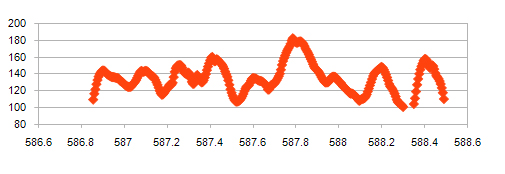
Nine annual layers in 1.65 m NEEM ice as seen in the Dielectric Profile (DEP). The x-axis shows the depth in meters and the y-axis has arbitrary units. DEP is a non-destructive method and the wiggles in the figure reflect the seasonal variation in impurity content of the ice. The relatively high peak at 587.8 m depth may be caused by elevated sulfate concentrations of volcanic origin. This will be determined when the same ice will be analyzed in the CFA laboratory. The ice at this depth is from about 1000 BC. The annual layer thickness has decreased from about 20 cm of ice in the top of the core to about 17 cm at this depth due to the thinning of layers with depth.
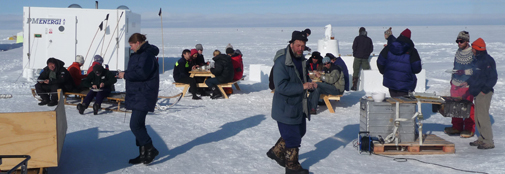
Enjoying a barbecue in the NEEM biergarten Sunday afternoon.
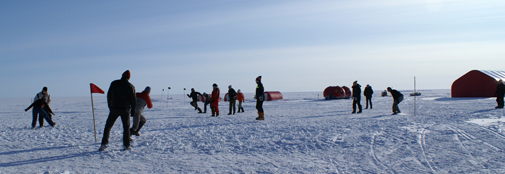
A game of ‘Rundbold’, the danish equivalent of baseball, in the nice Sunday evening
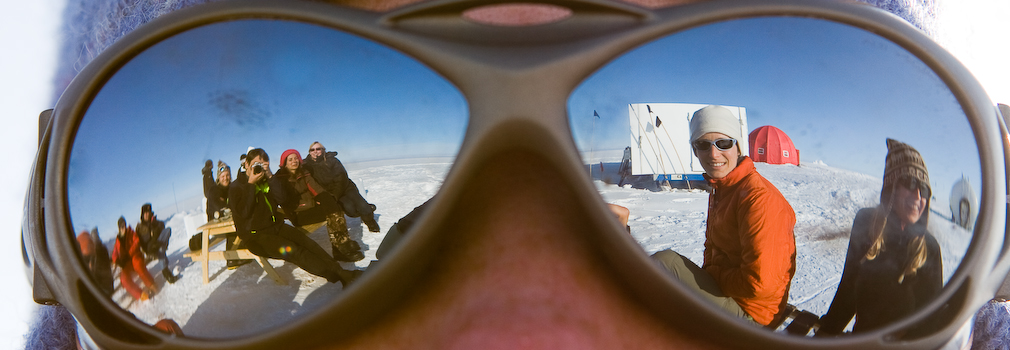
Apres ski
| ← Previous entry | Next entry → |

